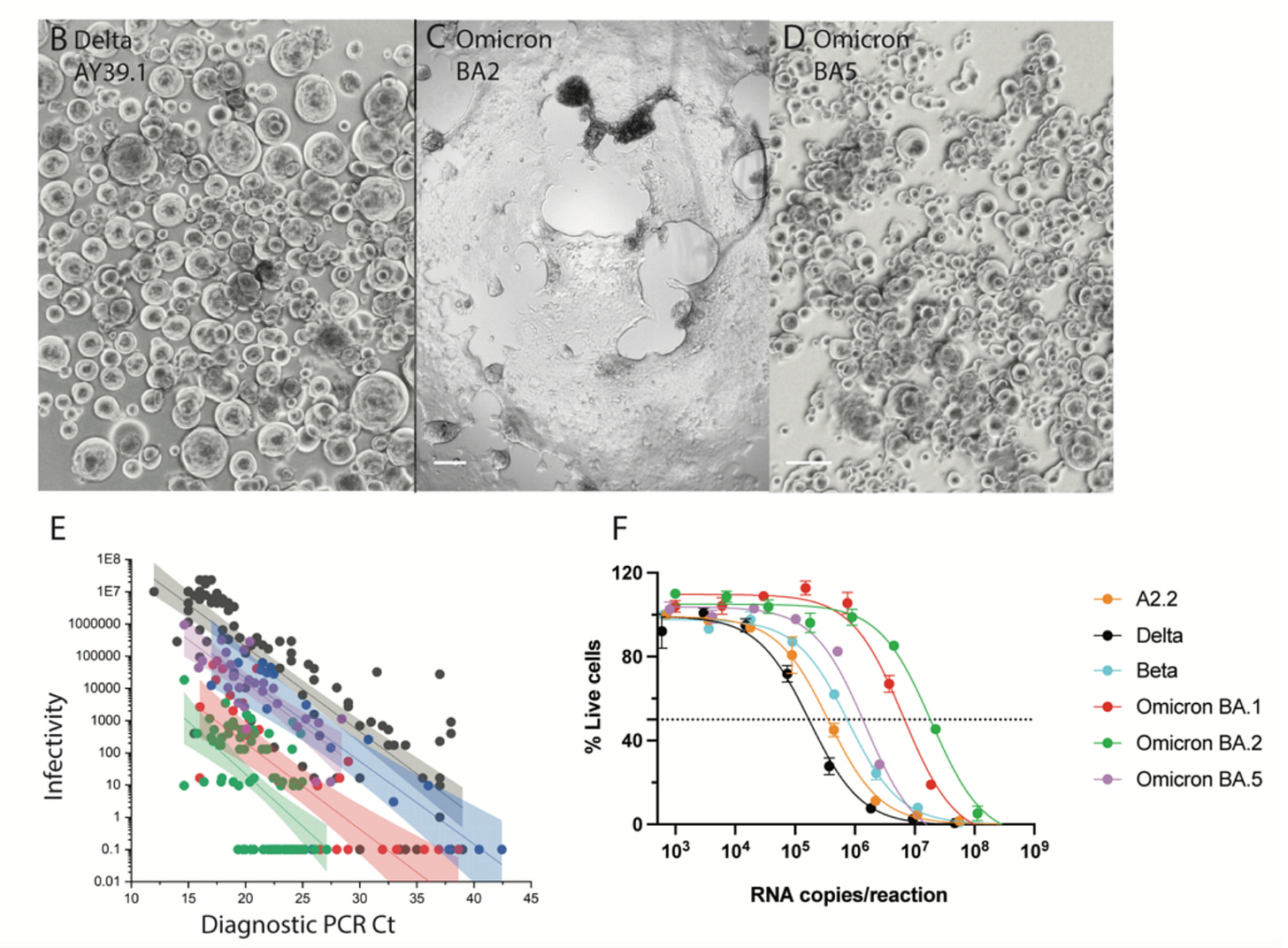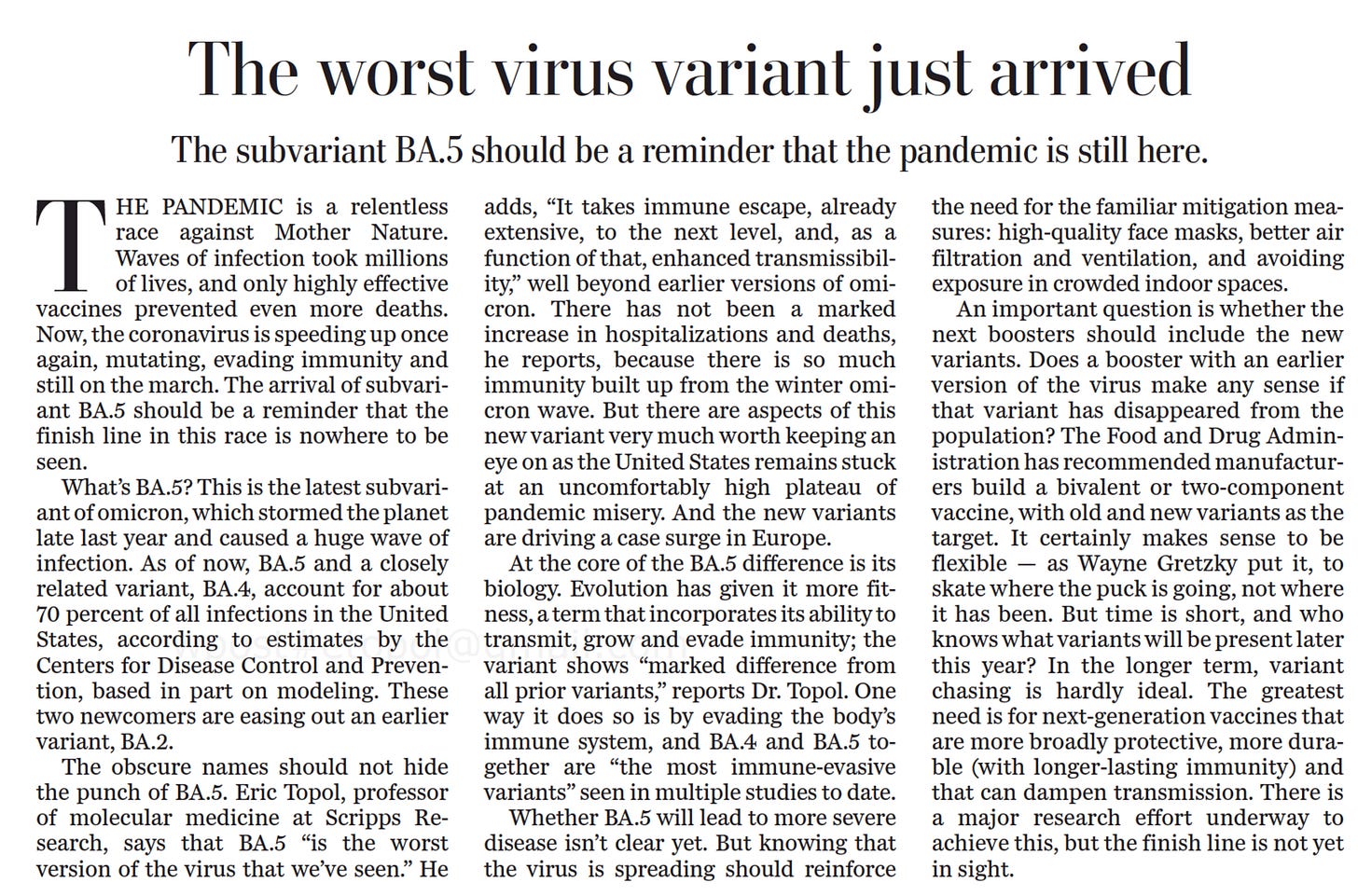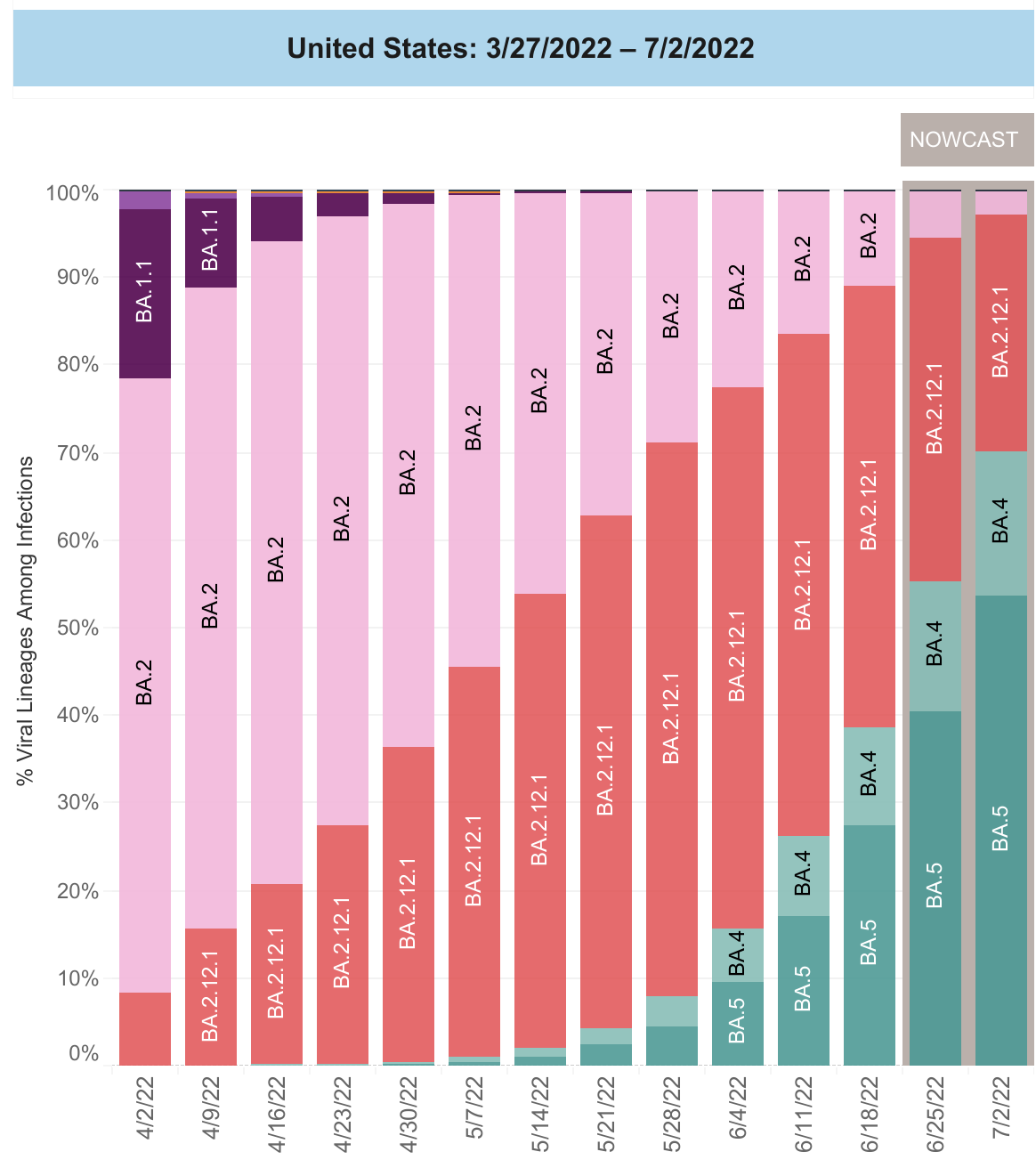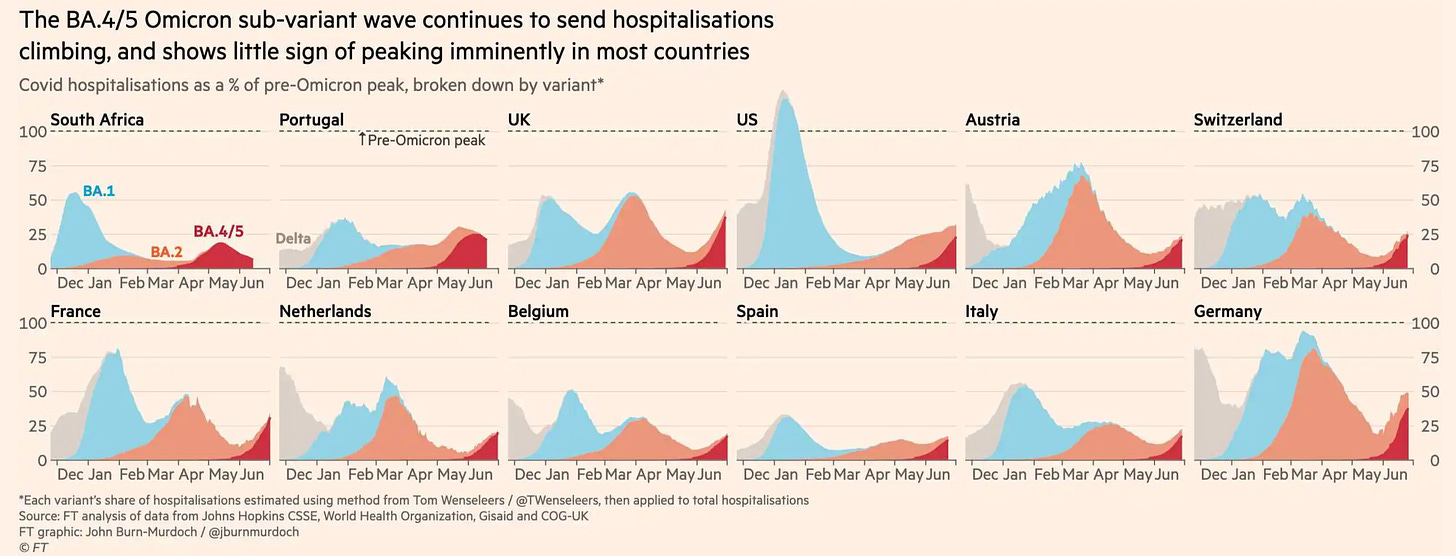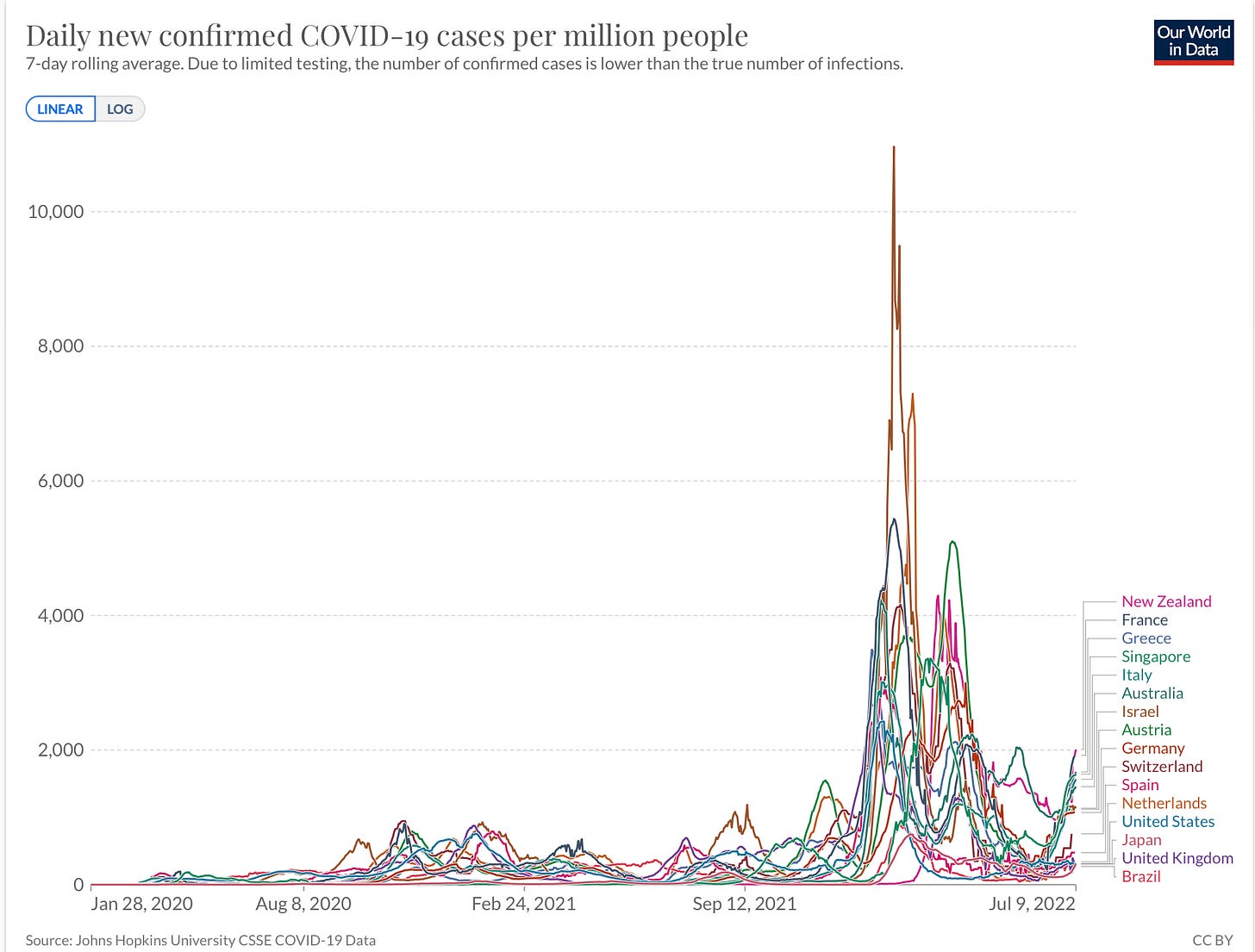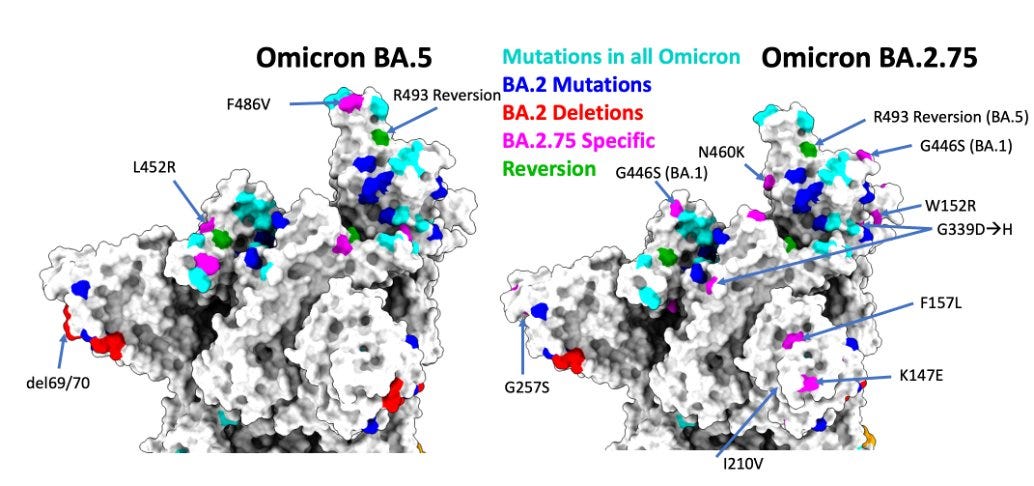Two weeks ago I tried to pull together all we knew about the Omicron BA.5 variant (The BA.5 story). I didn’t think another chapter about this variant would be warranted, especially this soon, but there’s been quite a bit of new data worthy of review.
As you may recall, I focused on the genomic and antigenic distance (and the fitness) of BA.5 compared with other Omicron family variants (BA.1, BA1.1, BA.2, BA.2.12.1) which explains the most immune evasion we have yet seen for a version of the virus. A new report from the highly regarded Kirby Institute in Australia takes the understanding of the biology of BA.5 a step further. You may remember the term “Deltacron” prematurely used many months ago in the pandemic, but the ability to infect cells for BA.5 is more akin to Delta than the previous Omicron family of variants. In the Panel F below you can see the shift to the left for copies of the virus, much closer to Delta than BA.1 or BA.2, and the cultures of the different variants in {Panels B, C, and D) that convey the similarity of virus high loads for BA.5 and Delta. This report is noteworthy because it extends the known immune escape property of BA.5 (shown to be less responsive to Evusheld monoclonal antibodies than prior Omicron variants) to also include enhanced infectivity. There are more copies of the virus because BA.5 has far better ability to get into cells (tropism related to TMPRSS binding efficiency) which may help explain why this version of the virus has caused a lot of trouble, more than other Omicron subvariants. This may align with the anecdotal reports of very long periods to test negative after BA.5 infections, often exceeding 10 days. (Note the CDC still guides us as 5 days as all that is required for isolation without ongoing symptoms and does not recommend the use of rapid antigen tests to screen for persistent infectiousness).
Yes, I called it the worst variant we have seen so far, which The Washington Post editorial board picked up on (and checked with multiple peers before publishing) because of its severity of immune evasion and transmissibility compared with any prior SARS-CoV-2 variant. Not because it causes worse illness, which is still unclear but possible given its Delta-like cell infectivity feature. It’s also hard to interpret that because of our immunity wall with extensive prior infections, vaccination and boosters. But if BA.5 presented without its BA.1 predecessor, it could have been worse than the massive surges we saw around the world with the arrival of Omicron. Our immunity wall makes a big difference for how we perceive the disease induced by each successive variant.
In the United States, the march of exponential growth for BA.5 has progressed to dominance, accounting for ~54% of current infections as of July 2nd, which is really toward the end of June with the known delays in sequencing and reporting.
What we are seeing in many countries in Europe and the United States is a pattern of increased BA.5-induced hospitalizations, still on the rise, but mostly well below what was seen in prior waves. The good news is that generally there is uncoupling from ICU admissions and deaths; that is, they are not going up nearly as much as the increase in hospitalizations. There were marked differences between South Africa and Portugal, the first 2 countries with BA.4/5 case spikes. While that may be attributed to difference in demographics and prior infections, I think it is intriguing that the Beta variant, which hit South Africa very hard and was barely seen in Europe and the US, seems to provide more protection versus Omicron variants than other previous strains, at least as demonstrated with a Beta-specific variant vaccine. While BA.4/5 has already fully descended in those 2 countries, BA.5 hasn’t yet peaked in many countries.
And many countries it is. Besides Europe and the United States, there are BA.5 new case spikes now in Israel, Japan, Singapore, New Zealand, Australia, Indonesia, China, and Brazil. Many of these case surges are also accompanied by an increase in hospitalizations.
In the United States, while the confirmed cases, representing only a small fraction of the actual new infections, has hovered around 100,000 for weeks, there has been a significant rise in hospitalizations and ICU admissions, although well below the initial Omicron wave (now pushing 40,000 instead of 160,000 hospitalizations at peak BA.1)
That 18-19% is less than the 40% increase in hospitalizations seen in France and 34% in England, and may in part be attributed to the descent of BA.2 concurrent with BA.5’s rise. As the FT coverage suggested: “The rate of increased hospital admissions in the US is currently slower than in Europe …This reflects the decline of the BA.2 variant in the US, the FT’s data analysis suggests. But as the BA.5 variant becomes dominant, the overall rate of growth is likely to accelerate.” It remains unclear whether the decoupling from ICU admissions will continue in the US which is now ranked 67th in the world for boosters, below Iran, Rwanda, Sri Lanka, Azerbaijan, and Tajikistan, to name a few. Not a good immunity wall here, to say the least.
For now there has clearly been a rise in reinfections in the United States, where tracking of reinfections is largely absent. In San Diego County where I live, the 2nd largest county in California, there has been a recent doubling of reinfections, and that may well be a gross underestimate due to lack of reporting of PCR confirmed cases. The reinfection rise is not at all surprising given the immune escape features that have been established for BA.5. Our best protection from BA.5 infections and reinfections now consists of high-quality, well-fitted masks, physical distancing, air filtration, ventilation and vaccination + boosters (as previously reviewed).
That gets me to the lede in the Washington Post’s BA.5 report today: “America has decided the pandemic is over. The coronavirus has other ideas.” The virus is still evolving and there are concerns about a BA.2.75 variant in India with different mutations than BA.5 that might be important, but it’s too early to know since this is occurring without the backdrop of competing with BA.5
There’s clearly more room for the virus to evolve, get more fit, gain advantages as an immune escape artist and more efficiently infect cells. Yet we are watching its accelerated evolution akin to the behavior of a Formula One race car lapping around the track with humans in the stands. At best, there will not be a BA-5 specific booster until November or December and that represents a failed strategy of variant-chasing, knowing full well that BA.5 will not be the dominant circulating virus in 5 to 6 months. We need to get ahead of the virus, stop acting as bystanders with “hope and prayers’ that it will not get worse than what we are dealing with now. No, BA.5 has taught us once again, the virus doesn’t just get milder and fade away. While the virus revs up its mutations under selection pressure, we’ve ironically become immutable, more resistant to taking an aggressive stance with second-generation and nasal vaccines that are clearly in our reach.

